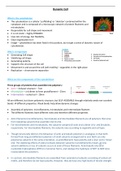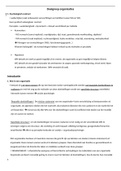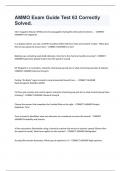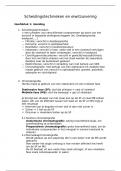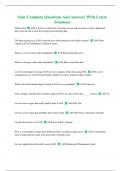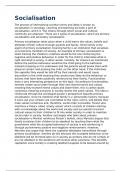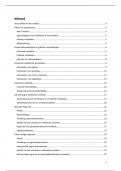What is the cytoskeleton
• The cytoskeleton is a cellular ‘scaffolding’ or ‘skeleton’ contained within the
cytoplasm and is composed of a microscopic network of protein filaments and
microtubules.
• Responsible for cell shape and movement
• it is not static – highly DYNAMIC.
• Uses lots of energy, but flexibility.
• Clear organisation to it
• Image – cytoskeleton has been fixed in this position, do not get a sense of dynamic nature of
cytoskeleton.
Why is it important
• Generating Cell shape
• Stabilising cell shape
• Generating polarity
• Supports the structure of the cell
• Movement in and around the cell (cell motility) – organelles in the right place
• Replication – chromosome separation
What are the components of the cytoskeleton
Three groups of proteins that assemble into polymers:
• Actin – heliacal structure – 7nm
• Microtubule – a-b dimer to form protofilament – 25nm
• Intermediate – coiled coil – 10nm
All are different, but share polymeric structure, but SELF-ASSEMBLE through relatively weak non-covalent
bonds → different properties. Weak bonds help allow dynamic changes
• Assembly of polymers: microfilaments, microtubules and intermediate filament.
• The different filaments have different roles and therefore different properties
• Actin filaments (microfilaments), microtubules and intermediate filaments are all polymers that arise
from repeating subunits that assemble end-to-end.
• For microfilaments and microtubules, the subunits comprise β-actin and a dimer of α- and β-tubulin,
respectively. For intermediate filaments, the subunits vary according to organelle and cell type.
• Though structurally distinct, the behaviour of actin and tubulin polymers is analogous in that both
formed from long protofilament polymers of small subunits arranged end to end. Both can only
polymerise subunits in the same orientation, so protofilaments have polarity and a 'plus' and a 'minus'
end. The stabilising effects of lateral contacts between subunits in protofilaments means all new
subunit additions or loss of subunits occurs at ends of these filaments. Actin/tubulin also bind
nucleotide triphosphates (NTPs) in monomer forms, and catalyse the hydrolysis of NTP to NDP once
incorporated into polymers.
• In contrast, intermediate filaments are assembled from symmetrical subunits consisting of coiled-coil
motifs, and therefore do not have polarity. However, they do have very high levels of tensile strength.
, Actin filament - stress fibres – bundles of actin
filaments that hold the cell down to a substrate
• Two stranded helical polymers of Actin
• Flexible structures with a diameter of 5-9 nm in
diameter
• Arranged in linear bundles (contraction), 2D networks
or 3D gels (drive alteration in cell shape/movement)
• The filaments are made up of globular monomers that
associate head to tail
• The filaments are unstable without associated proteins.
Most highly concentrated in the cortex of the cell
Microtubules
Form a series of tracks – move vesicles around
the cell. Generate cell polarity.
• Long stiff hollow tubes of protein –
tubulin
• Rapid disassembly/reassembly
• Microtubules grow from a microtubule
organising centre (MTOC)
• Create system of tracks within the cell for
organelle positioning and cell polarisation
Intermediate filaments
• Rope like fibres made of intermediate filament proteins (heterogeneous-unlike
actin and tubulin)
• Found in the cytoplasm of some eukaryotic cells and form the nuclear lamina in
animal cells
• Toughest and most durable of the three types of cytoskeletal filaments – provide
resistance to stress
• Particularly abundant in cells that are subject to mechanical stress such as muscle
cells, epithelial cells
• Often anchored at the plasma membrane at cell junctions. Provide tensile strength
for cells
All animal cells have a nuclear envelope. specialised inter filaments that are the least dynamic. Regulated
by phosphorylation. Durable. Odd ones out, cos v heterogeneous proteins, less dynamic.
Actin and tubulin form polar filaments
• Actin and tubulin relatively similar – we’ll treat as analogous
• Polarity – cos monomer asymmetric and binds ‘head-tail’ – so ends different + end –
ATP-binding cleft; - end C-terminus. Actin monomers all have the same orientation in
the filament. The filament therefore has ‘polarity’.
• If want to add or lose subunits, must be from ends, cos lateral connections stabilise
subunit binding in middle
• Also, monomers in cytoplasm always ATP bound (resting [ATP] much higher than ADP.
On incorporation, monomer changes configuration, causing hydrolysis of ATP→ ADP
Properties of each end is different. Polarized structure.
Plus end is ATP binding clef – molecule has to be rotated to match up with binding clef.
, Tubulin Filaments:
Dimer – alpha beta dimer. Intrinsically asymmetric
A-b dimer, but again self-associate in 1 orientation → + (b-tubulin) and – end (a-
tubulin). 13 protofilaments → long hollow tube- lateral binding (a-a and b-b,
slightly staggered)
Bind GTP in a-Tubulin molecule – stays bound, can ignore; but also GTP in b-
tubulin, but this does get hydrolysed to GDP; again, as free dimer in cytoplasm,
always GTP bound.
What is the significance of polymer polarity and why is ATP/GTP hydrolysis important?
• What happens in free solution – outside cell? Spontaneous
behaviour…..mix subunits, then increase [cation], by adding salt
• Lag phase – nucleation – rate-limiting step….. 3 actin monomers can self-
associate, stabilising the dimerization; so now adding next ones much
easier. Nucleation depends on random collision, so higher [monomers]
accelerates nucleation. Can show it is rate-limiting, buy seeding with
preformed filament seed s- straight into growth phase (no delay)
• Growth initially rapid, but as all polymerises, then [monomers] decreases
until reach steady state with free subunits – at critical concentration, Cc
• So can control amount of polymer by controlling free [monomer] e.g. after
growth you half local concentration of monomer, then depolymerises until
reaches Cc.
• Nucleation is the rate limiting step for polymer formation
• Critical concentration (Cc)= Concentration of free subunits (C) at
equilibrium (rate of subunit gain=rate of subunit loss).
• Polymerisation does not occur if C<Cc
• When C>Cc, polymer elongates until C reaches Cc. When C<Cc,
polymer will shrink until C reaches Cc
• Lag phase by nucleation unfavourable
Polymerisation of actin
Actin monomers in the cytosol carry ATP
The ATP is hydrolysed to ADP soon after assembly into filament. The ADP
bound monomer is less stable in the filament
The ADP cannot be exchanged for ATP until the monomer disassembles
In the cell the monomer conc is very high (above the CC).
the cell also has a series of mechanism based around
accessory proteins – that influce locally the dynamics and
conc of monomers. Control polymerisation. Controlled by
the cell.
• Actin and tubulin polymers form spontaneously from free subunits in solution as long as the free
subunit concentration (C) is above the critical concentration (Cc). The time it takes for random collision
of subunits to form a stable "nucleus" or "seed" polymer (e.g. collision of 3 subunits is necessary to
form an actin nucleus) leads to a "lag" phase before polymer growth can occur.
, • Polymers will continue to grow until C is depleted to levels equal to Cc: at this point the rate of subunit
loss from polymers is equal to the rate of subunit incorporation. Both the length of lag phase and the
average length of polymers are therefore governed by the starting concentration of free subunits.
• Rate of subunit association = association rate constant (kon) x C, while rate of subunit loss = the
dissociation rate constant (koff) alone (i.e. it is independent of C).
• At equilibrium rate gain = rate loss, or: konC=koff. Therefore, Cc=koff/kon
• The plus ends of actin/tubulin polymers have a higher kon than that of the minus
ends (i.e. the rate of subunit addition is higher at the plus ends). In the absence
of NTP hydrolysis, exactly the same subunit interactions would be broken at
either end of the polymer, and the subunits themselves after dissociation are
identical, so the free energy change (ΔG, which governs the equilibrium position
and therefore Cc) would be the same at both ends.
• That is, even if the kon and koff values are different, the ratio of koff/kon would be
exactly the same, and therefore so would the Cc (i.e. the slow rate of addition at
the minus end would be matched by an equally slow rate of dissociation).
• Because NTP hydrolysis DOES happen shortly after subunit incorporation into
polymer, the Cc can be different at the plus and minus ends. The energy released
by NTP hydrolysis is incorporated into the polymer, and the affinity of NDP
subunits is reduced towards its neighbours. In other words, the ΔG for
dissociation of an NDP subunit is negative and therefore energetically
favourable: rates of NDP subunit loss are so much higher than rates of NTP
subunit loss that the latter can be considered insignificant.
• If the rate of NTP-subunit addition exceeds the rate of subunit loss, then the polymer will grow. Because the rate
of addition at the plus end is higher, then it is likely that a polymer of considerable length can build before the
rates of NTP hydrolysis can catch up and cause any NDP-subunit loss, whereas at the minus end it is far easier for
hydrolysis to catch up, meaning it will often be likely to shed subunits.
• Therefore, there is a greater propensity for polymers to gain
subunits at the plus end and lose them from the minus end. This
is precisely the reason TREADMILLING in actin occurs when C >
Cc for NTP subunits at the plus end, but < Cc for NDP subunits at
the minus end. Because a solution of subunits is never a uniform
concentration (especially in a cell), the stable NTP-subunit
"caps" at the growing plus ends of polymers can spontaneously
be lost as the local concentration of subunits is depleted below
the Cc, which will cause the polymer to shrink until the local
concentration is above the Cc again.
• These rapid transitions of growth and shrinkage account for the
DYNAMIC INSTABILITY most often associated with microtubules.
• TREADMILLING and DYNAMIC INSTABILITY are properties that the cell has evolved to
control, in order to facilitate diverse behaviour, such as the control of intracellular
transport and cell locomotion.
‘working hard to stay in same place….but can be used
to drive movement….blue subunit effectively moves
from front to back of polymer


